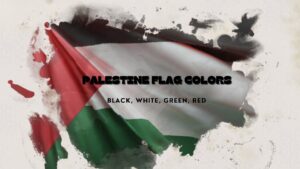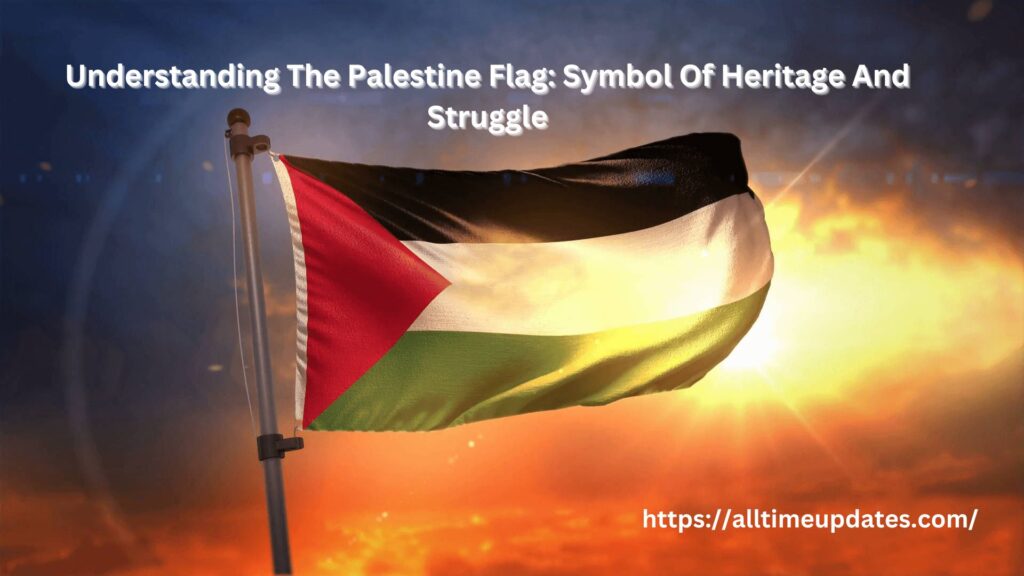The Palestine flag has come to symbolize its nation and fight for independence for over five decades since being adopted in 1964 by the Palestine Liberation Organization. With three horizontal bands consisting of black, white, green, and black with an added red triangle representing Arab Dynasties such as Abbasid Umayyads, Fatimids Umayyads, etc., each color symbolizes something important about Palestine, such as heritage or independence struggles for independence or sovereignty from colonization by other powers such as Umayyads Umayyads, etc.
The flag design contains three horizontal bands representing various Arab Dynasties, such as Abbasids Umayyads Umayyads Umayyads, with a red triangle on top representing different colors representing each dynasty that existed over time, such as Abbasids Umayyads Fatimids Fatimids Umayyads Umayyads Umayyads/Umayyads/Fatimids/Fatimids, etc…., respectively. Meanwhile, the red triangle is a symbol of the Hashemite Dynasty as well as that of the Arab Revolt against Ottoman rule.
This flag has been an emblem of Palestinian determination and resistance that is flown in protests and international protests. Also, it has cultural significance, unites Palestinians across the globe, and is displayed across various forms of art. The Palestine flag’s importance in representing the Palestinian determination to establish a state was emphasized in 2015 when it was erected at the United Nations headquarters. In its role as a symbol representing the past and an ongoing struggle, The Palestine flag continues to motivate and unify those who advocate for Palestinian rights and their identity.
The History Of The Palestine Flag
Background to the Palestine flag The Palestine flag’s history can be found within Arab nationalist ideology as well as the Palestinian struggle for self-determination. It can be traced back to mid-20th century use during World War I when the Arab Revolt against Ottoman Rule occurred – initially; it consisted of three horizontal strips made up of green, black, and white colors, with its original conception taking place during 1916 with three stripes composed of these colors on each horizontal band conceived at this time. It also featured a red triangular design at the hoist’s side. This design represented the unity and aspirations of Arab society; its flag represented this goal as well.
In 1964, The Palestine Liberation Organization (PLO) adopted an amended flag representing both Palestinians and their desire for self-determination.
The flag adopted by PLO remained in its original colors and style but added special significance to the Palestinian struggle. The black stripe represents the Abbasid Caliphate, while the white stripes stand for the Umayyad Caliphate; the green represents the Fatimid Caliphate; finally, the red triangle represents the Hashemite Dynasty as well as the Arab Revolt.
Over many decades, the Palestinian flag has long been used as an emblem to symbolize Palestinian resistance during their struggle. From 1987-1993 to 2000-2005 (both Intifadas), Palestinian resistance against Israeli occupation was symbolized by flying this flag during protests, rallies, and international gatherings, as it represented both their identities and demonstrated the strength of people’s power.
2015 marked a historical event when the UN General Assembly adopted a resolution authorizing the hoisting of the Palestine flag at UN headquarters in New York. This landmark victory marked global recognition of Palestinian efforts towards sovereignty and statehood. It represented their history, struggle, and hope for independence in an irreversibly visual fashion.
The Design And Symbolism Of The Palestine Flag
The Palestine flag is an eye-catching visual that holds great historical and cultural meaning for its nation. The design consists of three horizontal strips in black, white, and green, with an optional red triangle on either end for hoisting purposes. Every element of the flag has a significant symbolic significance, denoting distinct periods and features in Arab and Palestinian historical events.
The black stripe on high on the flag represents the Abbasid Caliphate, an important Islamic Dynasty that ruled from between the 8th and 13th centuries. The Abbasids are renowned as the people who contributed to Islamic sciences, culture, and civilization, which makes the black stripe an emblem of intellectual and cultural history.
The white stripe that runs through the middle symbolizes the Umayyad Caliphate, another significant Islamic Dynasty prior to the Abbasids. The Umayyads were famous for their extensive empire, accomplishments in architecture and administration, and symbolizing the historic depth and government of this Arab world.
The green stripe on the lower right represents the Fatimid Caliphate, which was founded and ruled areas including North Africa and the Middle East from the 10th to 12th century CE by an Islamic empire known for its academic progress and cultural achievements. Hence, their legacy is recognized with pride today through symbolic green stripes representing knowledge and prosperity.
The red triangle visible on the hoist side represents the Hashemite Dynasty and the Arab Revolt against Ottoman rule in World War I. It symbolizes the struggle for independence and unification among Arab nations.
Together, the colors and forms represent the cultural and historical traditions of the Palestinian population and their wider connection with their place in the Arab world. The flag represents not just Palestine’s desire for self-determination and independence but is also used as a unifying symbol to unite Arab identities, strength, and hope for lasting peace and sovereignty in its region.
The Palestine Flag in International Context
The Palestine flag has gained an important international status, a symbol of the Palestinian struggles for statehood, and an identity. The flag’s popularity extends far beyond Palestinian areas, with prominent appearances at international solidarity rallies and in international gatherings. It is an effective symbol for Palestinian militants, which symbolizes their love for the cause of Palestinian rights and their right to self-determination.
Alongside political events, it is employed in social media campaigns or protests as well as festivals across the world. It is a unified symbol of Palestinians and their supporters and conveys a message of hope, resilience, and the desire for justice. With its global presence, The Palestine flag is a constant source of worldwide solidarity for Palestinian causes.
The Role of the Palestine Flag in Cultural Identity
The Palestine flag plays a significant function in shaping and representing the identity for people of the Palestinian people. Beyond its political implications, this monument stands as an incredibly potent representation of Palestinian history and pride, as well as unity within their nation. It stands as a monument for both those living inside occupied territory as well as those scattered abroad – it represents both past and present Palestinian cultures as well as hopes and aspirational dreams shared among generations of Palestinians both inside and outside their nation’s borders.
In Palestinian communities across the globe, The flag is often used during festivals of culture or national holidays, as well as celebrations with family members. It provides a concrete bond to the country as well as fosters a sense of connection and unity among Palestinians regardless of physical area. The flag serves as a symbolic depiction of their common experience and struggle to be independent.
Additionally, the Palestine flag appears frequently in media and art. It is featured in artworks and murals, music videos, and films. The flag symbolizes struggle, hope, and determination. Creators and artists use the flag to communicate important messages regarding Palestinian identities, struggles, and the pursuit of justice and peace.
By featuring prominently at daily social events, cultural activities, and artistic expressions involving Palestinians—from daily social meetings and cultural celebrations to artistic creation—the Palestine flag strengthens Palestinians’ sense of unity. It stands as an unwavering sign that their unyielding dedication and spirit remain committed to protecting cultural heritage as they work towards realizing a sovereign statehood goal.
Palestine Flag Colors

The colors of the Palestine flag hold significant symbolic meaning and represent significant moments from Palestinian and broader Arab history. Composed of three horizontal stripes–black, green, white, and black–plus an orange triangle on its hoist end–this flag boasts deep symbolic weight.
Black: The Abbasid Caliphate was an influential Islamic family that reigned between the 8th and 13th centuries. They were famed for their contributions to religion, science, literature, and intellectualism—the black stripe is symbolic of this intellectual and cultural tradition.
White: The white stripe running along the middle represents the Umayyad Caliphate, which came prior to Abbasid rule and played an influential role in expanding Islam across its empire, famous for their architecture and administrative achievements. The white stripe symbolizes historical wisdom and the quality of their governance.
Green: The bottom green stripe symbolizes the Fatimid Caliphate, which ruled over portions of North Africa and the Middle East from the 10th to 12th centuries AD. These rulers were celebrated for their intellectual achievements; therefore, this stripe’s symbolism becomes all the more poignant! Green is often associated with progress, wealth, and understanding—this stripe stands as a testament to such feats!
Red: The red triangle on the hoist side symbolizes the Hashemite Dynasty and The Arab Revolt against Ottoman rule in World War I. It represents the struggle for freedom, bravery, and unity between Arab nations.
Together, these shapes and colors represent the diverse historical and cultural history of the Palestinian people and their wider connection to the Arab world. They also represent the Palestinian character, determination, and aspirations for self-determination.
The Palestine Flag In Art And Media
The Palestine flag is an incredibly powerful symbol that appears frequently across various art forms and in multiple media. Its appearance demonstrates the historical importance and the ongoing struggle of Palestinians. Palestinian people. Below are some of the methods of displaying the flag:
Visual Arts
- Street Art and Murals: The Palestine flag is an atypical design in street and mural art in the Palestinian territories and around the world. Artists use it to communicate messages of protest, hope, and solidarity.
- Paintings: Numerous Palestinian and other artists incorporate the flag into their work to draw attention to Palestinian culture and cause. The paintings often portray everyday scenes of fighting, resilience, and struggle.
Music and Videos
- Music Videos: Palestinian musicians and bands frequently use the flag in their music videos, expressing patriotic pride and the struggle for freedom. The flag is used as the backdrop to songs that reflect Palestinian life and dreams.
- Concerts and Performances: When performing live, musicians wave the Palestinian flag in support of Palestinian citizens and their cause.
Films and Documentaries
- The Palestine flag is featured in a variety of documentaries that explore the past, culture, and struggles of the Palestinian population. It serves to define the stage and trigger emotions.
- Films for Feature The feature film often features flags in scenes depicting demonstrations, celebrations of the national flag, and reflections that emphasize its importance in the Palestinian story.
- Through these creative and media depictions, The Palestine flag is able to continue to enthuse and educate global viewers about the Palestinian nation’s identity as well as their search for self-determination and justice.
The Future of the Palestine Flag
- The Palestine Flag represents the hopes and struggles of its population; serving as an emblem of resistance, identity, and hope, it remains integral in Palestine’s quest for self-determination and statehood.
- In the coming years, the Palestine flag will be a major feature in international and local settings. In the Palestinian territory, the flag will serve as a symbol of solidarity and perseverance, expressing the spirit of the whole nation fighting to fulfill justice and freedom. The flag will be displayed during rallies, national events, and cultural celebrations to serve as a constant reminder of the ongoing fight for freedom.
- On the international stage, the Palestine flag will probably obtain additional recognition because Palestinian causes continue to draw international attention. Its participation in conferences on global issues, including those of the United Nations, and its participation in international solidarity rallies will highlight the continuing call for Palestinian rights and a state. The raising of the flag in front of the UN headquarters marked a major event, and further developments may increase the power of symbolic symbolism.
- As Palestinian citizens continue their fight to be recognized and sovereign, the Palestine flag will serve as a symbolic representation of their history, identity, and hopes – guiding future generations who strive for justice, peace, and self-determination.
Conclusion
The Palestine flag represents more than just national pride: It represents its heritage, cultural identity, and continuing struggle as part of global consciousness. Drawing inspiration from Arab Revolt designs reminiscent of Arab Revolt flags of old, its design captures historical connections while reflecting aspirational desires for unity and independence among Palestinian peoples. Being widely displayed at international forums as well as art shows and media campaigns underlines this significance globally.
As Palestinians pursue self-determination and recognition, their flag remains an iconic symbol of resistance, hope, and solidarity. It serves as an instantaneous reminder of shared history and collective aspirations; furthermore, it represents resilience, unwavering commitment, and unyielding belief that a sovereign state exists; through this powerful symbolism, the flag continues to advocate for peaceful resolutions to their cause.

